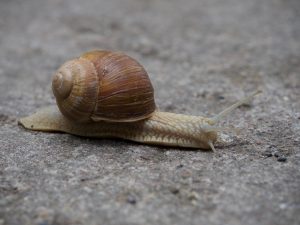
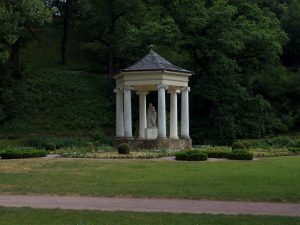
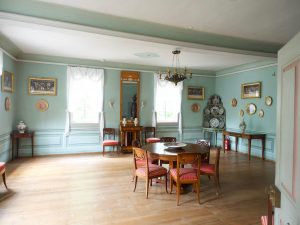
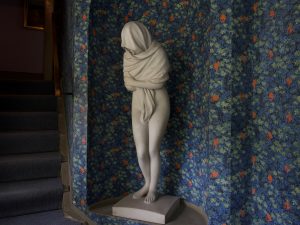
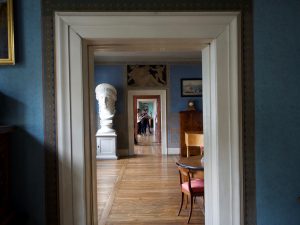
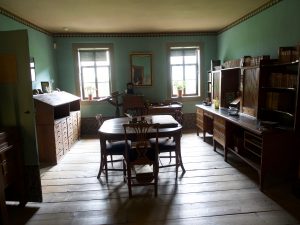
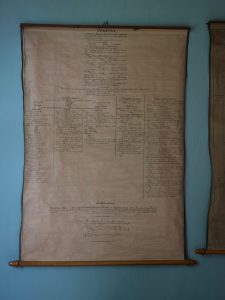
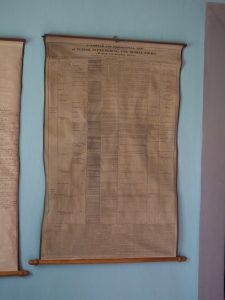
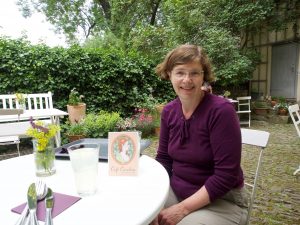
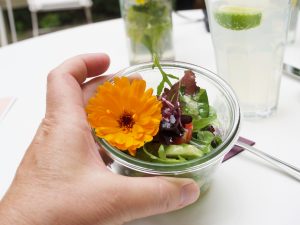
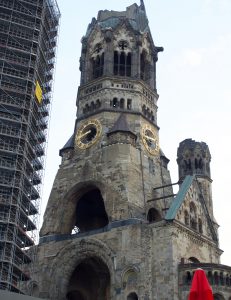
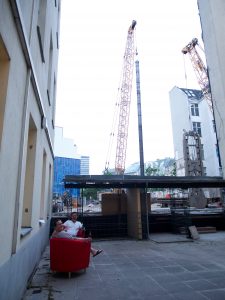
We got up a little bit later than we have been, and had a leisurely and delicious hotel breakfast from their buffet. I was able to double-check with the woman at the reception re: a memory I had of a very lovely walk to Tiefurt Castle, an 18th-century estate not far from Weimar that is tourable, and she gave us some extra directions. Then we set out, again with no rain in the forecast, and walked the 3.3 kilometers (2.5 miles) to Tiefurt on a bike path that quickly led from town through the woods and then gardens to this estate. We saw hundreds of snails and slugs on the path (Mark took a representative portrait), and when we later saw a street sweeping vehicle clear the bike path, Mark made me laugh out loud by suggesting that it was a snail-picker-upper.
Tiefurt is an estate that was designed and built by Anna Amalia, the duchess whose son Carl August transformed Weimar into the arts and culture center it was to be throughout the 18th century. Initially, it was intended for Constantine, her younger son. When Constantine died rather young, at 41, his mother used the estate as her own summer residence. It has a huge, lovely park area with lots of little stopping points that she had put into the park design—monuments to various people including Constantine and her husband, who died young, but also to Mozart and Virgil, and even more generically the Muses, which have a little templet right by the river. There are lots of open spaces and many walking paths, and we walked toward the actual „Schloss“ (not much of a palace, but more of a large estate) through most of the park. The Ilm, the same river that runs through Weimar and its park, also runs through the park. The estate didn‘t open for tours until 11, so we found a little cafe and had a snack and a cafe au lait (well, I did have the coffee; we shared the snack), and looked at the village church and the spot where there had been a water mill on the Ilm since the Middle Ages (a teeny hydroelectric plant is still in that spot, but we couldn‘t quite see it).
Then we took a tour of the Tiefurt estate, in big felt slippers to protect the floors. Although it belonged to the ruling family of the Weimar region, the furniture and decor were simple because the taste of Anna Amalia was fairly sparse 18th century neoclassicism, except when it came to the porcelain, which seemed fairly ornate. But overall, the simplicity that reigned made the house very appealing, and most of the art work was also neoclassical and quite streamlined. We liked the statue of the „freezing woman“ in the hallway on the way to the apartment of Anna Amalia‘s Lady in Waiting, but the really loud wallpaper behind it was a pretty stark contrast. There was also what I would think was the first „fan room“ for Goethe, dedicated to him and featuring several Goethe-related portraits and scenes from his novel The Sorrows of Young Werther.
We left a little before noon and walked back the same way we came. It took us about 45 minutes to get back to town, and we found our way to Herderplatz and to the „Herder House,“ where the writer and philosopher Herder lived in Weimar for many years on Goethe‘s invitation (until he died at in the early 1800s at age 59). I had remembered from my trip with Uschi 9 years ago that there was a little garden and a little cafe in the house, and we actually decided to have lunch there—a simple but lovely meal out in the garden. I had potatoes with apple cream and Mark had spaghetti with pesto and arugula, and we both had a beautiful salad with an edible flower (nasturtium, I believe) and a glorious shot glass of panna cotta for dessert.
We then walked to the Goethe House and decided to make that our last stop for the day. Touring that house was both a nice continuation from Tiefurt and quite different—some features of the neoclassical furniture were quite similar, but there was much, much more art, since Goethe was such a collector of art, including majolica plates by the hundreds. Even if he didn‘t fill all of his rooms with the art that is in them now, the decor and the space is made for the copies and sketches of Roman and Greek statuary, including the giant head of „Juno“ (it wasn‘t really Juno, but that‘s what Goethe and his contemporaries thought). The back rooms, where Goethe and his family actually lived, are now filled with Christiane Vulpius / Goethe‘s wife‘s heirlooms. Christiane was his common-law wife before he officially married her, but I didn‘t realize that of his four children, only his oldest son, August, survived his childhood, got married, and had children of his own (he later committed suicide in Rome, where I‘ve seen his grave). And then there are the really interesting back back rooms, where Goethe lived in very sparse surroundings after Christiane‘s death. He didn‘t want to be surrounded by comfortable furniture, because he claimed that took away his motivation to work. He had a study with a sitting and a standing desk, a library (currently empty because the books are getting digitized), and a bedroom that didn‘t have a heat source (the servant‘s room next to it did!). That‘s also the room where he died, sitting in his armchair, in 1832, after a very long life of incredible fame, and I remembered that bedroom well from my last visit. The most interesting feature are actually two „posters“ on the wall, one with information on music theory and the other with geological terminology. Goethe apparently used posters like these all his life as study aids and had them hanging on his walls to learn things. Pretty amazing.
We took a quick peek at the garden that came with the house (which incidentally was bought for Goethe by Grand Duke Carl August, and which Goethe‘s last living grandchild bequeathed back to the ruling family, then represented by Carl Alexander, in the 1850s or 1860s). Since that was basically like giving it back to the state of Saxe-Weimar, the house could immediately become a museum (one of the oldest tourable houses by a writer or artist). Our last somewhat rushed stop was the actual Goethe exhibit in the building adjacent to the house, where a lot more art and artifacts relating to him are displayed. So I could show Mark some of the early fandom products (people bought Goethe medaillons and crockery as early as the 1770s, and famously people dressed in the yellow pants and blue stockings that his character Werther says he is wearing at one point in the bestselling Sorrows of Young Werther. We also looked at some of the scientific collections (rocks, minerals, plant specimen, fossils) and the work for the color theory that Goethe was developing (he got optics wrong, but at least he tried). And I was glad to see that some of his collection of ancient erotic art actually made it into exhibit, too. I always liked that Goethe wasn‘t a prude!
But then we had to leave—it was getting past 3 pm, so we rounded up our luggage at the hotel, took it to the nearby bus station, and took the bus to the train station (NO MORE LUGGAGE LUGGING!). We had enough time for me to absorb more information about the instrumental role that Karl Alexander (ruler from 1853-1901—Karl August‘s grandson, and the son of Maria Pavlova of the little Orthodox Chapel on the cemetery we saw yesterday) played in preserving so much of Weimar‘s cultural history and heritage. Many of the buildings and collections wouldn‘t have survived without him, and he was even responsible for erecting the famous Goethe and Schiller monument in 1857.
We then had a seamless trip from Weimar via Erfurt to Berlin and got to the main station at 6:30, and to our hotel right by the Kurfürstendamm by 7 pm. We found ourselves a little Asian fusion place with outside seating for dinner, checked out the famous church ruin, the Kaiser-Wilhelm-Gedächtniskirche (deliberately left as ruin after being bombed during WWII, and meant to be a reminder of the devastations of WWII) and the fountain by the Europa center on the way back to our hotel. Since we are on the ground floor this time, and so low that it’s possible to climb out the window into an atrium that overlooks a massive construction site, we ended up having a funny conversation with our neighbors, who heaved some of their furniture outside to lounge about (and smoke), and asked whether we wanted to come out and have a beer with them. But we were ready for bed, so we didn‘t end up partying with them—I guess we are old fuddy-duddies!